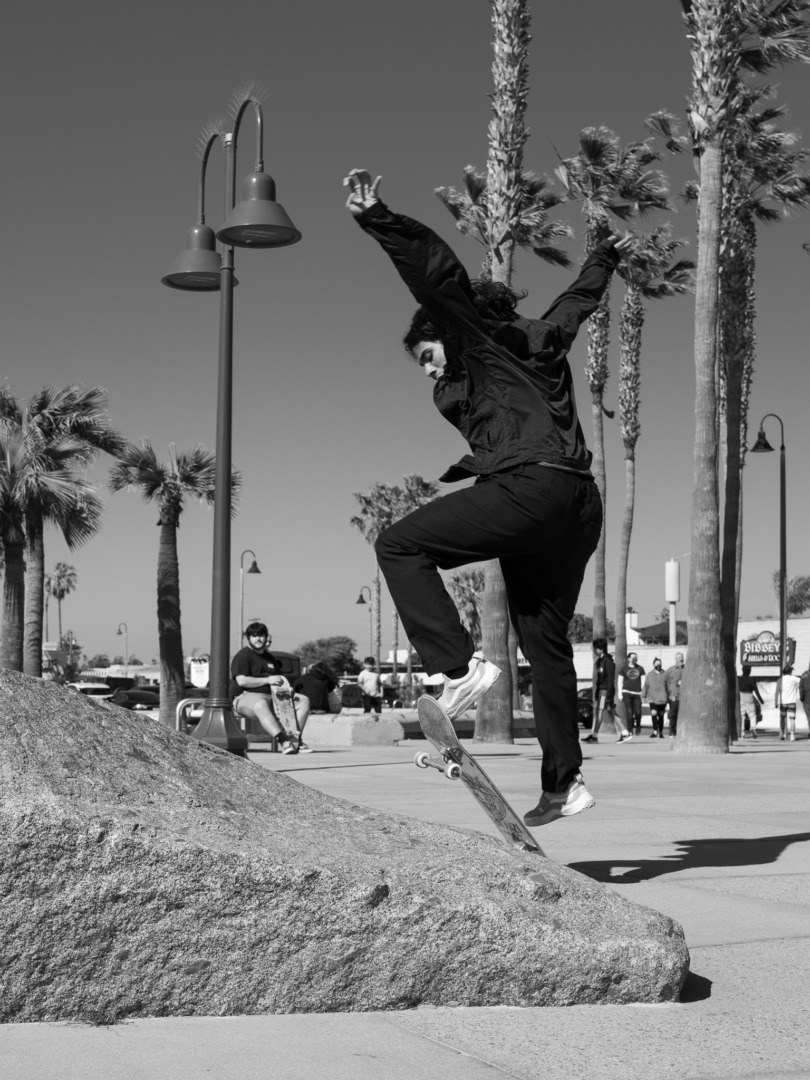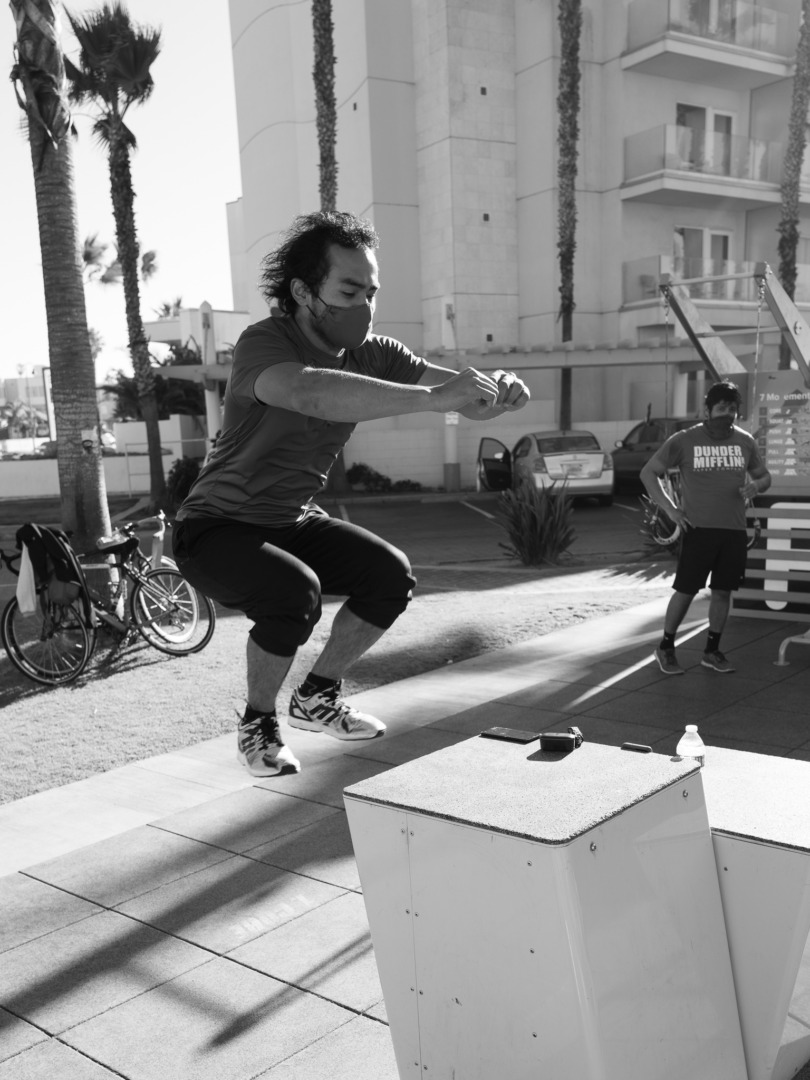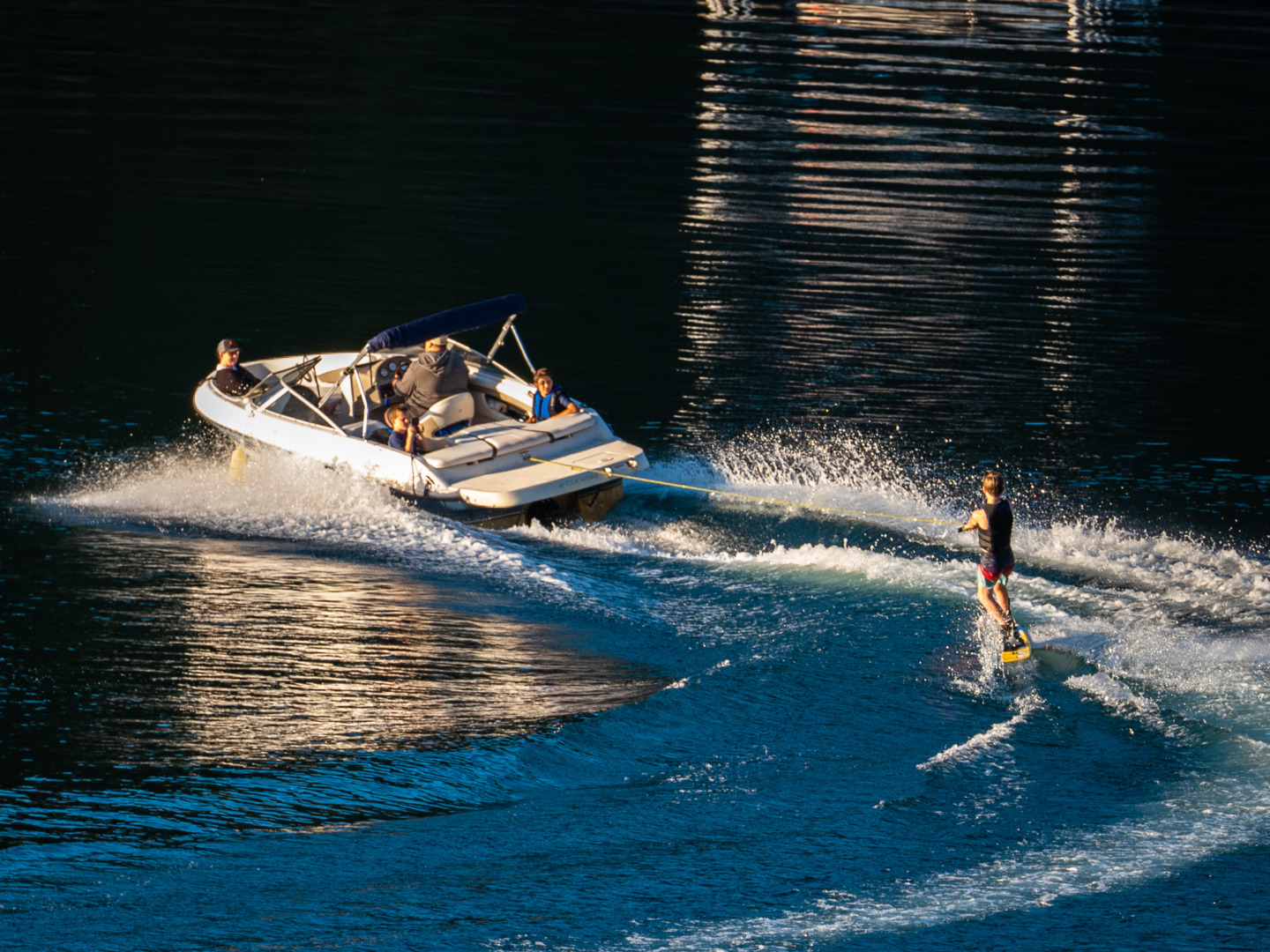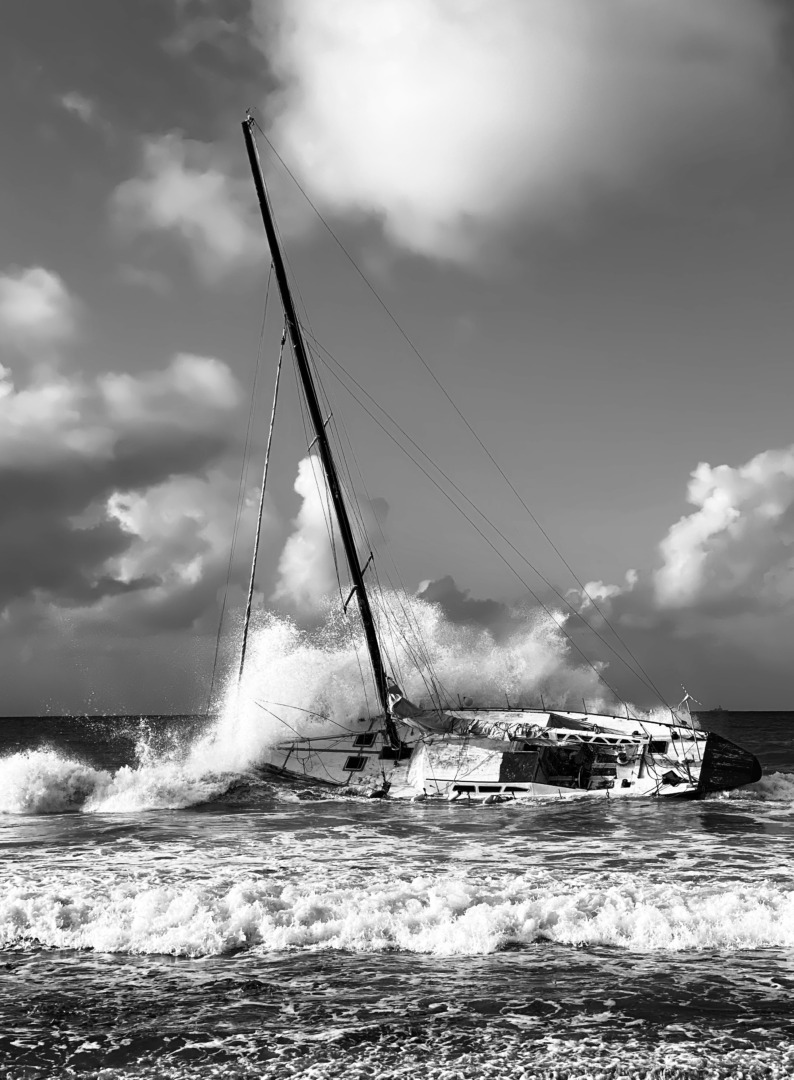In the blink of an eye, a camera shutter opens and closes, and an image of the world through the lens is recorded.
The resultant photograph constitutes an imperfect representation of that world — two dimensional, a field of view distinct from the human gaze, and capturing a fleeting moment in time, as the future sweeps through the present and into the past.
Of all the ways recording a photographic image differs from how we perceive reality, the most fascinating might be that ability to trap a split-second in time, freezing an object’s motion partway through its trajectory, allowing us to see something otherwise unseeable.
Our perception of reality is determined by our brain’s ability to integrate information gathered through our sensory systems with our understanding of how the world works, our memories, and our sense of passing time. In real life, things move. Our ability to perceive moving objects is governed by the speed at which our brain can process sensory information from the rod and cone cells in the retina, whose function is to detect fluctuations in light.
This physiological system is phenomenal at tracking objects in motion, but is not without limits: air force pilots can recognise a plane from an image flashed up for just 1/220s of a second, but at 1/250s it becomes invisible.
Of course, a human’s ability to track a moving object depends on its size, its distance from the viewer, and its light reflection. Watching a tennis ball gently bouncing up and down on a racquet just in front of you is one thing, but following the motion of a tennis ball served at over 100 mph from a vantage point behind the umpire’s chair at Wimbledon is barely possible.
Cognitive dissonance
Cameras do not suffer from these limitations of the flesh. Exposure of an electronic sensor to light from a moving object, using a shutter speed significantly faster than the motion of the object, can magically and perceptually freeze the object, as though floating in mid-air.
My brain is usually able to rationalise that what I am seeing is, indeed, a moment caught in suspended animation. Nevertheless, such images possess an otherworldly quality, and can even be confusing when the subject of the photograph appears to defy the physical laws of the universe, provoking a sense of cognitive dissonance.
The relative juxtaposition of shutter speed and object motion within the field of view affords a spectrum of potential photographic outcomes: frozen motion when shutter speed is fast; a blurry image when shutter speed is slow; and an aesthetically pleasing lack of focus when shutter speed and object motion are comparable.
Now the owner of a camera with control of shutter speed, aperture and ISO, I have enjoyed trying my hand at capturing images of people and objects frozen in motion, or at that point of tasteful blurring of motion. The most arresting images have turned out to be photographs of people doing something remarkable, but my modest collection also contains one or two pleasing images of inanimate objects, literally caught in the act.
The juggler
Let me start with one of my favourites — an acrobatic juggler named Edgar on a unicycle, on a slack rope, juggling a set of clubs. Two of the clubs are frozen, crossing in mid-air, bright and shiny in contrast to the dark sky. I spotted him as I cycled by, and was inspired to stop, turn around, and ask if I could take his photo. Like a number of the people captured in these shots, he was delighted to display his skills for the camera.
Edgar is staring intently at the two airborne clubs, looking supremely cool in his shades, whilst readying the two clubs in hand to be launched into the air. In the distance is a bridge that happens to align with his shoulders. The photograph was taken in bright sunlight, which cast deep shadows in the surrounding sand and allowed a shutter speed of 1/1000s at f/5.6. It was taken with a Leica Q2 using spot autofocus aimed at Edgar.
Cyr wheel
The next photograph shows another acrobat named Liz practising her skills with an apparatus called a Cyr wheel. The device, a large steel or aluminium ring slightly taller than the performer, is named after Daniel Cyr, a circus performer who brought it to prominence at the end of the last century.
Practitioners use their body weight to control the gyroscopic motion of the ring, achieving a series of breathtaking spins and twirls in which they appear to be on the verge of a disastrous crash. Of all the freeze-frame images I have taken, these provoke most strongly the sense of how can this be possible? They were taken with a Panasonic Lumix S5, equipped with the superb Lumix 85 mm f/1.8 lens, shooting at f/10, 1/320s.
Sk8tr boi
The skateboarder in the next photo goes by the name of Mario. He and his buddies, one of whom is facing away from the camera in the adjacent photo, were using a large, sloped rock embedded in a paved walkway as a ramp via which they could propel themselves into the air. Mario was a tough-looking character, and initially wary of being photographed, agreeing only on condition that I send him copies.
As soon as I laid out prone on the paved surface to aim the camera upwards for the shot, Mario and the lads began their routine, and I began snapping. The 28 mm Summilux on my Q2 delivered the goods, capturing the skaters and backdrop with the aperture set at f/5.6 and the camera choosing a shutter speed of 1/640s. Mario was delighted with the results.
Woolly jumper
On the same afternoon, a little further along the street, I encountered an open-air, public fitness centre, where a personal trainer was coaching a young client. His routine involved jumping onto pedestals of varying height, and as he demonstrated his prowess, I was able to grab a couple of hurried shots.
The Q2 happened to be set at f/4, yielding an auto-selection of 1/400s for the shutter speed. In the first photograph, the jumping motion is clearly evident. In the second (just before he landed) he appears to be levitating. The masks on both the coach and the client date the photos as mid-pandemic; in fact, 26 December 2020, which readers in the UK will recognise as Boxing Day — a good time to wrap up warmly.
Service with a smile
Sports, even of the amateur kind, provide rich opportunities for dissecting the relative motions of people and objects through photography. As a keen tennis player, I have tried capturing tennis buddies in action since I knew exactly where to point the camera and could set the focus in advance of the serve.
Here is a shot of Doug exhibiting athletic form, falling forward as he throws his racquet at the ball tossed into the air slightly in front of himself. His momentum has lifted him off the ground, and although the ball appears motionless, his racquet certainly does not. The shutter speed (1/400s, f/5.6, 100 mm focal length) is not quite fast enough to fully freeze its motion, giving a pleasing blur, adding dynamism to the shot.
Just for fun, I coloured the floating tennis ball fluorescent yellow using the ‘Color Splash’ app — not to everyone’s taste I suspect, but a nifty use of this effect.
Netflicks
Another popular San Diego net-and-ball sport is beach volleyball. Taken with a telephoto zoom lens set at 220 mm, this photo from a slightly elevated acute-angle perspective along the net shows a ‘left-wing spiker’ launching himself off the sand to punch the ball over the net.
The forceful thrust used to achieve lift-off results in a spray of sand from his right foot, his fingers splayed to control the ball nestled in his palm, ready to be driven across the net.
Even though the Sigma 100-400mm telephoto zoom is slow (maximum aperture f/6.3 at this focal length), the bright sunlight permitted a shutter speed of 1/1000s, freezing the action and suspending the player in mid-air.
Surfer dude
Surfing is a bonafide option for ‘gym class’ here in Southern California, a reflection of the young age at which kids learn to surf and the athleticism required to be proficient.
This young man has been caught executing a turn, swinging his board over the wave before heading back out to catch another. He is leading with his right foot, hurling out arms and bending knees to retain his balance.
The photo was taken from a promenade around 100 yards away, with a focal length of 330 mm, and at 1/600s, f/6.3 in morning sunlight. The chilly splashing water and the surfer’s wet-suited form are frozen in place.
Family affair
Although a water sport practised on lakes rather than oceans, water skiing demands similar balance and coordination skills to surfing. This early morning jaunt is probably a family affair: father steering the powerboat while mother and brothers look back admiringly at a son navigating the turn on a mono-ski.
The scene took place a considerable distance from my vantage point on a terrace overlooking the lake, requiring the full 400 mm zoom capacity of the lens (1/500s, f/6.3, hand-held), as well as a little digital zooming to frame the scene to my satisfaction. Again, a shutter speed in this range freezes the boat’s wake and highlights the early morning ripples on the lake.
Noise pollution
Jet skis provoke strong feelings! Some people love them. Others find them obnoxious noise polluters and safety hazards. Nevertheless, they are regular features on San Diego Bay. The tandem riders in this photograph seem intent on generating lots of wake and splash as they spin around in a ‘doughnut’ near the shore. It was taken from a passing ferry, again using the excellent Lumix 85 mm f/1.8 lens, with aperture f/2.5 and shutter speed 1/4000s.
Splash bang wallop
Talking of frozen splashes, here is an iPhone photo of a rather sad scene encountered while walking the beach one morning after a storm. The yacht pictured had become unmoored during the night, driven onto the shore, and relentlessly pummelled by waves. The local Coast Guard considered the conditions too dangerous to make a rescue attempt.
By the end of the day, the boat had been smashed to smithereens, pieces of its wooden hull distributed hundreds of yards along the beach. Not bad for an iPhone shot methinks, as did the editor of the local paper, who published the photo with an article about the disaster. Unfortunately, no details are available regarding shutter speed or aperture.
The Birds
As illustrated by the surf crashing against the beached yacht, sometimes non-human subjects frozen in motion can make for interesting photographs. Here is an elderly couple feeding seagulls on a pier. As the gulls hover and swoop to collect the birdseed thrown into the air, their bodies are sharp but their wings are slightly blurred.
The shutter speed is down at 1/100s with the aperture at f/16 on a Leica Q2, providing a wide depth of field and crisp rendition of the wooden pier and distant buildings. I think of this as an example of street photography at the pier, with some Hitchcock vibe thrown in for good measure.
’Copter capture
Here is a US Naval Seahawk helicopter making its approach to the North Island Naval Base in Coronado. They are a regular sight in the local skies, and this one happened to pass overhead while I was wandering along a road near the beach with the Sigma 100-400mm zoom mounted on my Lumix S5.
Some quick zooming (to 280 mm focal length) and composing allowed me to capture this hand-held shot at 1/800s (f/7.1) in which the tips of the main and tail rotors are not quite frozen. I continue to be impressed by the coupled in-body and in-lens image stabilisation of this camera-lens pair.
Aeroplane
Anyone flying into San Diego International Airport at night will have marvelled at how close the aircraft flies to the downtown high-rises. Those skyscrapers are of course much further away than they appear, but we are so unused to seeing objects at eye level through the windows of a plane in flight that the effect is both thrilling and slightly unnerving. This photograph of a Delta Airlines flight seen through the gap between a few of those tall buildings illustrates how passengers enjoy a close-up view of the city as they speed past.
Unlike the photo of the Seahawk helicopter, this was not an impromptu shot, hurriedly zooming and composing whilst tracking a moving object. Having recognised the possibility of such a shot while walking the Bay, it was a case of finding a vantage point where incoming flights would be visible between buildings, choosing camera settings and focus, waiting for flights to appear, and then pressing the shutter as they entered the gap. This one was taken at 400 mm, 1/800s at f/7.1 while sitting on a park bench with the lens wedged between my knees.
Blur
The last couple of examples were taken using a very different shutter speed range from earlier photographs, wherein either the subject of the photograph or the camera itself, are changing position significantly whilst the shutter is open.
The first was captured on a 25-mile bike ride around the San Diego Bay, featuring a trip across the Coronado Bridge while the westbound lane was closed to traffic. Riders whizzed past me as I stood, dismounted at the edge of the road, Leica Q2 in hand, tracking bikes as they approached down the slope. This rider, probably moving at around 25 mph, flew by as I pressed the shutter (1/80s at f/5.6), capturing a blurred but recognisable image against a backdrop of bikes and cars navigating the curving bridge.
This final shot was taken after dark, at a traffic-light-controlled junction, panning the Q2 and snapping shots at a shutter speed of 1/15s (f/1.7, ISO 200) as cars scooted through the intersection. I found speeds of 1/15s to 1/60s to be optimum for yielding clear images of the vehicles against a blurred background of streetlights and illuminated shop windows.
Frozen
Now I am on the lookout for more examples of people, creatures, and objects in motion that I might freeze in place with my wide apertures and fast shutter speeds. I have found focal lengths all the way from 28 mm to 400 mm fair game in hunting down these opportunities, with the proviso of plentiful sunlight when selecting the longer end of the range.
I love wandering around, stumbling across interesting opportunities for freeze-frame photography, albeit requiring pre-selection of settings, use of autofocus, and a quick composition to get the shot. For me, this is all part of the fun — pitting my wits, my reflexes, and my shutter speed against the unpredictable and ever-moving world around us.
Read more from the author
Join the Macfilos subscriber mailing list
Our thrice-a-week email service has been polished up and improved. Why not subscribe, using the button below to add yourself to the mailing list? You will never miss a Macfilos post again. Emails are sent on Mondays, Wednesdays, and Fridays at 8 pm GMT. Macfilos is a non-commercial site and your address will be used only for communications from the editorial team. We will never sell or allow third parties to use the list. Furthermore, you can unsubscribe at any time simply by clicking a button on any email.




















Love how you captured the ACTION, I could never have the patience to accomplish that unless by pure luck, to me the B/w gave them the gravitas the moment deserved.
Hi John, much appreciated! I am prepared to hang around in most circumstances, waiting for the right moment, but eventually my patience runs out too! All the best, Keith
Thanks for aa truly interesting article. Captures are spot on.
Jean
Hi Jean, many thanks! I am glad you enjoyed it. All the best! Keith
An inspiring article on capturing action. You have skillfully captured the peak moment. I love the image of the sailboat being pounded by the surf. Your black and white images are a visual treat. The green ball is brilliant. Thanks!
That’s very kind Brian – thank you for both reading the article and adding encouraging comments. Much appreciated! All the best, Keith
Hello Keith.
Thanks for the writeup.
Your article provoked an immune reaction for me – back in work life I flew into San Diego airport many times, sometimes on days when gusty winds were blowing around the buildings on approach. We used to joke that we could see the papers on the work desks of the folks in those business offices.
The specially accredited pilots certainly know how to “thread the needle”.
I do realize that it’s your prerogative to present monochrome. They’re your images, but I would have loved to have more of them in a restrained Leica colour palette. There’s some lively subject matter in there.
Thanks very much Wayne. Glad the article brought back (pleasant/unpleasant!) memories of flights into San Diego. Thanks also for your feedback on BW vs color for the photos; several friends said how much they liked the ‘Family affair’ shot in color, and so will definitely be thinking about that consideration in the future. All the best! Keith
Keith: Very much enjoyed your photo essay. You make a wonderful case for slowing down our daily life to see incredible scenes that are hiding in plain sight. Did that serve of Doug’s have topspin?
Hi Peter – many thanks! I am pretty confident that Doug’s serving style is more about power than spin! Cheers, Keith
What a wonderful article Keith and with images that are amazing on many fronts.
Funnily enough, and something that replicates on my Flickr page – the IPhone image shows an amazing quality that I can see why local media would have lapped up, even in print. I find occasionally that IPhone images give many of my Leica ones a good run for their money. And while the top two images are Leica, the third is owned by Apple and the IPhone 11.
Thank you for this enjoyable segway into my weekend.
Hi Dave, thank you so much! It was great fun compiling these photos and organizing them in this theme. These days I try to have my camera with me whenever I am out and about, but there is no doubt that in a pinch, having an iPhone at hand means an interesting shot is not going to escape! Cheers, Keith